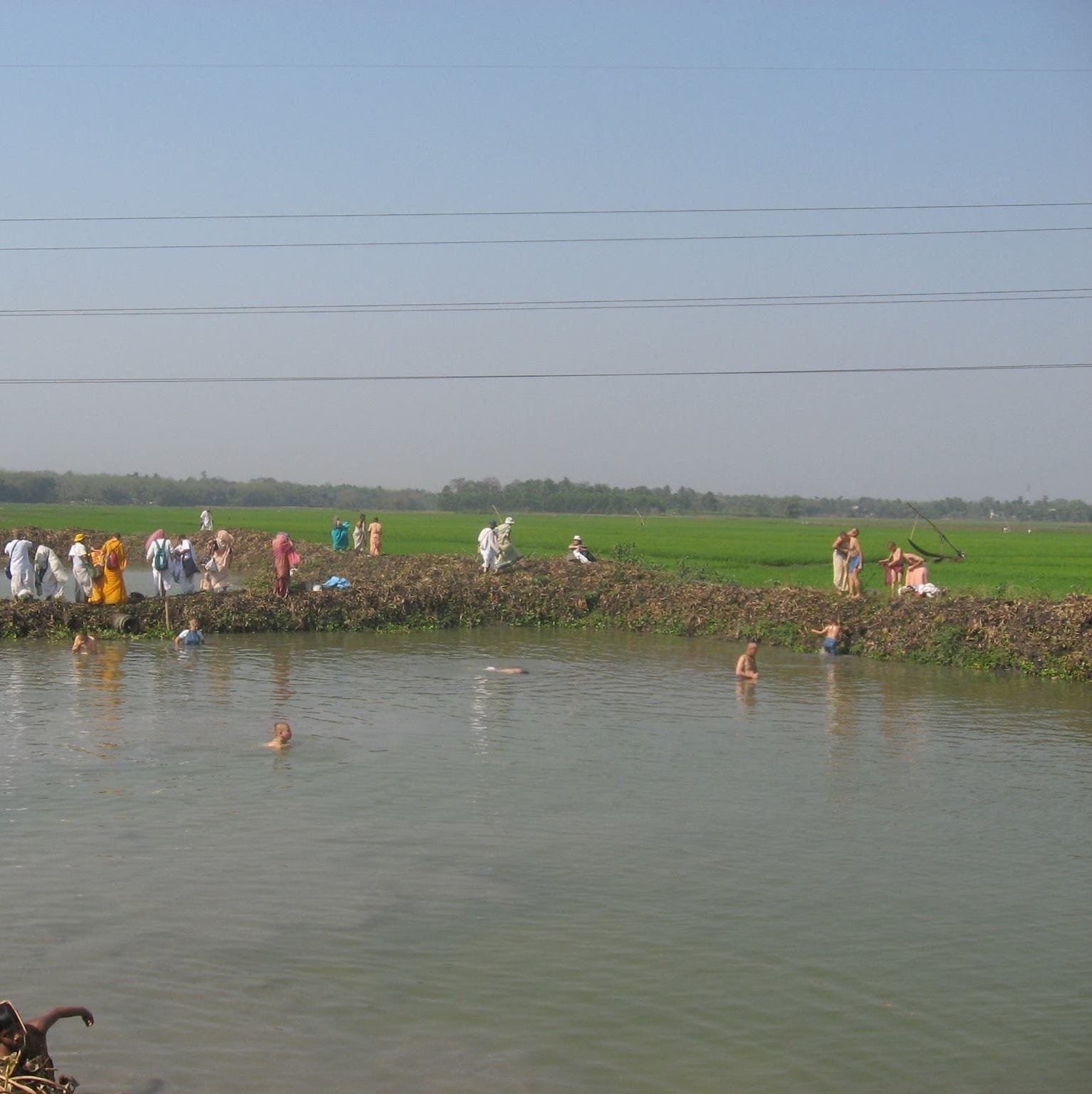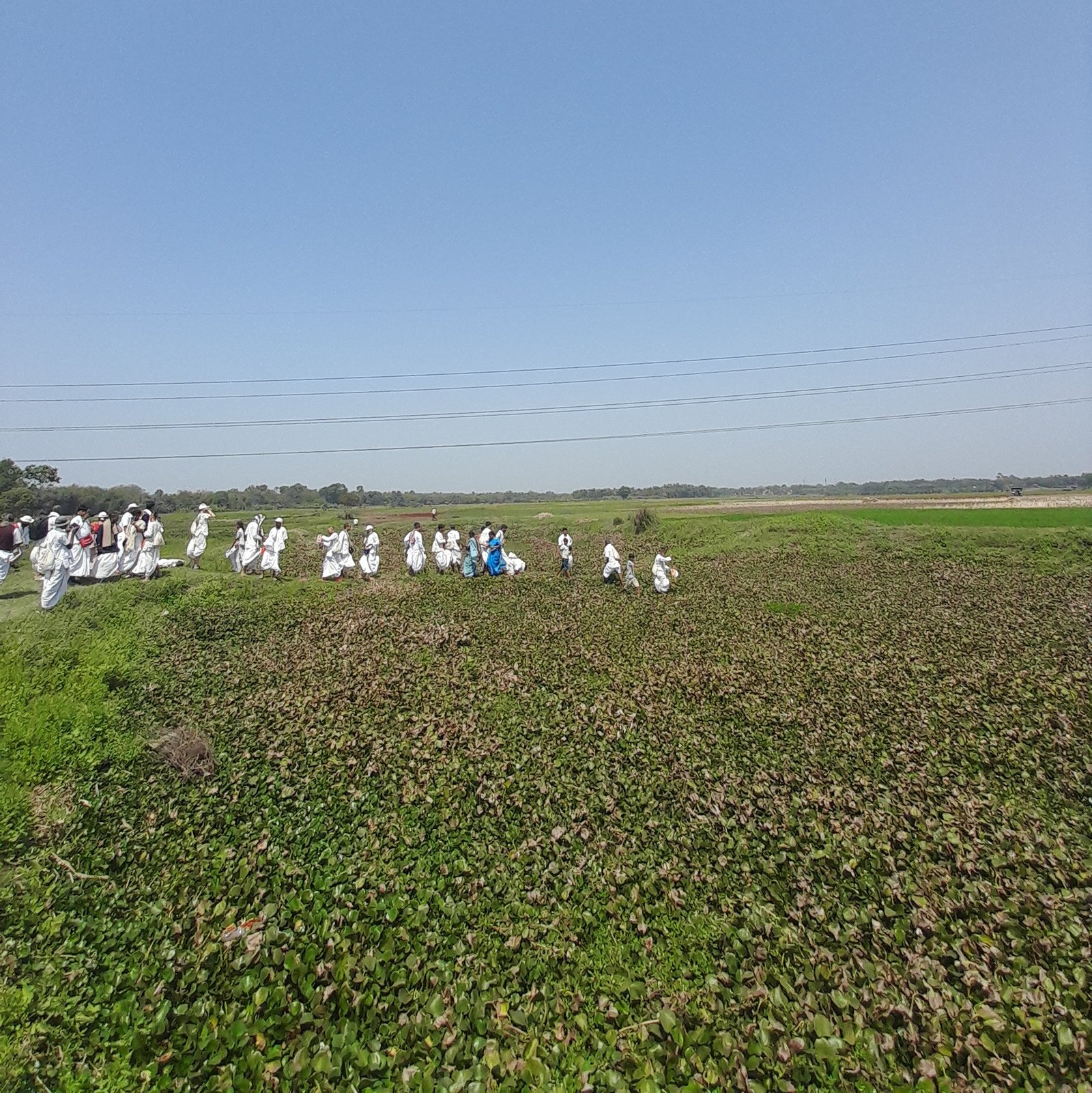
Ratupura (Radha Kund & Syam Kund)
Arriving at Rtudvipa and seeing the splendid forest, the son of Saci remembered Radha-kunda and began to weep.
(Sri Navadvipa-Dhama-Mahatmya, Pramana-Khanda, Chapter 4)
Enchanting Rtudvipa is filled with attractive forests. The seasons headed by spring perform eternal service to the Lord here. This Rtudvipa is the abode of transcendental bliss, for it is part of the area of Radha-kunda in Vraja. While singing the glories of Krsna and remembering Kṛṣṇa’s pastimes as a cowherd, sometimes Gauranga would loudly call again and again the names of the cows, “Syamali! Dhubali!” He would then cry as He called out for Subala and Śrīdāma. When will I wander in Rtudvipa, seeing the beauty of the forest and remembering the Lord’s pastimes? Then I will become stunned as the pastimes at Radha-kunda manifest before my eyes. Here, on the bank of Manasa-ganga, Kṛṣṇa and Balarama with Dāma, Bala, and Mahabala, go to solitary forests with countless cows and calves. While playing various games, all the boys sing the glories of Krsna. As the cowherd boys engage in various discussions, the calves go off grazing in distant forests. Losing sight of the calves, all the boys become anxious, but the calves immediately come running at the sound of Krsna’s flute. As I see this pastime, it suddenly vanishes, and I will fall to the ground unconscious. Then, regaining my senses, I will rise up and wander slowly through the forests.
(Sri Navadvipa Bhava-taranga)
“This is the place of Radha-kunda!” He exclaimed. “Here in the afternoon, Gaurahari would perform kirtana with His associates. Look at the brilliance of Syama-kunda, which attracts the minds of everyone in the universe! And look, here and there are the sakhis’ groves. In the afternoon, Gauranga would become immersed in singing Krsna’s glories and satisfy all by distributing prema. Know that in the three worlds there is no equal to this place, where the devotees worship the Lord. Whoever lives here will get love of God, which will soothe the burning fire of material life.”
That day the devotees stayed there and drowned in love of God as they called out Gaurānga’s name. Staying there in Rtudvipa, they passed the whole day and night worshiping the moonlike Lord Caitanya. The next day Nityananda Prabhu, dancing all the while, came to Vidyanagara, a splendid place attractive to munis. This gladdened the devotees.
Holding the devotees’ feet and begging from them the treasure of kṛṣṇa-bhakti, this worthless and unqualified Bhaktivinoda, whose only wealth is the lotus feet of Nitai and Jāhnavā, sings the glories of Nadia.
(Sri Navadvipa-Dhama-Mahatmya, Chapter 12)
Śrī Caitanya Mahāprabhu asked the local people,"Where is Rādhā-kunda?" No one could inform Him, and the brāhmaṇa accompanying Him did not know either.
(CC Madhya 18.4)
The Lord then understood that the holy place called Rādhā-kuṇḍa was no longer visible. However, being the omniscient Supreme Personality of Godhead, He discovered Rādhā-kuṇḍa and Śyāma-kuṇḍa in two paddy fields. There was only a little water, but He took His bath there.
(CC Madhya 18.5)
When the people of the village saw Śrī Caitanya Mahāprabhu taking His bath in those two ponds in the middle of the paddy fields, they were very astonished. The Lord then offered His prayers to Śrī Rādhā-kuṇḍa.
(CC Madhya 18.6)
Of all the gopīs, Rādhārāṇī is the dearmost. Similarly, the lake known as Rādhā-kuṇḍa is very dear to the Lord because it is very dear to Śrīmatī Rādhārāṇī.
(CC Madhya 18.7)
'Śrīmatī Rādhārāṇī is most dear to Lord Kṛṣṇa, and Her lake known as Rādhā-kuṇḍa is also very dear to Him. Of all the gopīs, Śrīmatī Rādhārāṇī is certainly the most beloved.'
(CC Madhya 18.8)
In that lake, Lord Kṛṣṇa and Śrīmatī Rādhārāṇī used to sport daily in the water and have a rāsa dance on the bank.
(CC Madhya 18.9)
Indeed, Lord Kṛṣṇa gives ecstatic love like that of Śrīmatī Rādhārāṇī to whoever bathes in that lake even once in his life.
(CC Madhya 18.10)
The attraction of Rādhā-kuṇḍa is as sweet as that of Śrīmatī Rādhārāṇī. Similarly, the glories of the kuṇḍa [lake] are as glorious as Śrīmatī Rādhārāṇī.
(CC Madhya 18.11)
'Because of its wonderful transcendental qualities, Rādhā-kuṇḍa is as dear to Kṛṣṇa as Śrīmatī Rādhārāṇī. It was in that lake that the all-opulent Lord Śrī Kṛṣṇa performed His pastimes with Śrīmatī Rādhārāṇī with great pleasure and transcendental bliss. Whoever bathes just once in Rādhā-kuṇḍa attains Śrīmatī Rādhārāṇī's loving attraction for Śrī Kṛṣṇa. Who within this world can describe the glories and sweetness of Śrī Rādhā-kuṇḍa?'
(CC Madhya 18.12)
Śrī Caitanya Mahāprabhu thus offered prayers to Rādhā-kuṇḍa. Overwhelmed by ecstatic love, He danced on the bank, remembering the pastimes Lord Kṛṣṇa performed on the bank of Rādhā-kuṇḍa.
(CC Madhya 18.13)
Śrī Caitanya Mahāprabhu then marked His body with tilaka made from the mud of Rādhā-kuṇḍa, and with the help of Balabhadra Bhaṭṭācārya, He collected some of the mud and took it with Him.
(CC Madhya 18.14)
The spot where we now find Śrī Rādhā-kuṇḍa was an agricultural field during the time of Caitanya Mahāprabhu. A small reservoir of water was there, and Śrī Caitanya Mahāprabhu bathed in that water and pointed out that originally Rādhā-kuṇḍa existed in that location. Following His directions, Śrīla Rūpa Gosvāmī and Sanātana Gosvāmī renovated Rādhā-kuṇḍa. This is one of the brilliant examples of how the Gosvāmīs excavated lost places of pilgrimage. Similarly, it is through the endeavor of the Gosvāmīs that all the important temples at Vṛndāvana were established. Originally there were seven important Gauḍīya Vaiṣṇava temples established in Vṛndāvana, namely, the Madana-mohana temple, Govinda temple, Gopīnātha temple, Śrī Rādhāramaṇa temple, Rādhā-Śyāmasundara temple, Rādhā-Dāmodara temple and Gokulānanda temple.
(CC Adi 10.90 purport)
Rādhā-kuṇḍa . . . who will live Rādhā-kuṇḍa? One is topmost devotee, and if he mixes with third-class devotee, how he is fit for living in Rādhā-kuṇḍa? There is no difference between Rādhā-kuṇḍa and Rādhārāṇī. So how you can jump over Rādhārāṇī? Rādhā-kuṇḍa and Rādhārāṇī, nondifferent. How you can enjoy Rādhā-kuṇḍa by swimming in it? You cannot touch with your feet even Rādhā-kuṇḍa. You can take little water and keep it on the head. That is respectful to Rādhā-kuṇḍa. Of course, things are going on like that, but strictly speaking, Rādhā-kuṇḍa should be respected as Rādhārāṇī herself. That is Rādhā-kuṇḍa consciousness, highest Rādhā-kuṇḍa consciousness.
(760905 - Conversation B - Vrndavana)

Among the many such transcendental lovers of the Supreme Personality of Godhead, the gopīs are the best, and among the gopīs Śrīmatī Rādhikā is the best. Śrīmatī Rādhikā is very dear to Lord Kṛṣṇa, and similarly Her ponds, namely, Śyāma-kuṇḍa and Rādhā-kuṇḍa, are also very dear to the Supreme Personality of Godhead.
(CC Adi 7.18-19)
Āriṭ-grāma is also called Ariṣṭa-grāma. Śrī Caitanya Mahāprabhu understood that in that village, Ariṣṭāsura was killed by Śrī Kṛṣṇa. While there, He inquired about Rādhā-kuṇḍa, but no one could tell Him where it was. The brāhmaṇa accompanying Him could also not ascertain its whereabouts. Śrī Caitanya Mahāprabhu could then understand that the holy places known as Rādhā-kuṇḍa and Śyāma-kuṇḍa were at that time lost to everyone's vision. He therefore discovered Rādhā-kuṇḍa and Śyāma-kuṇḍa, which were two reservoirs of water in two paddy fields. Although there was very little water, Śrī Caitanya Mahāprabhu was omniscient and could understand that formerly these two ponds were called Śrī Rādhā-kuṇḍa and Śyāma-kuṇḍa. In this way Rādhā-kuṇḍa and Śyāma-kuṇḍa were discovered.
(CC Madhya 18.3 purport)
The Lord then understood that the holy place called Rādhā-kuṇḍa was no longer visible. However, being the omniscient Supreme Personality of Godhead, He discovered Rādhā-kuṇḍa and Śyāma-kuṇḍa in two paddy fields. There was only a little water, but He took His bath there.
(CC Madhya 18.5)
